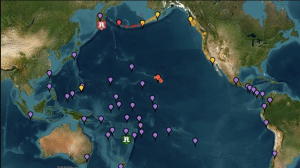
8.8-Magnitude Earthquake Causes Tsunami In Russia and Japan, Sets Off Warnings for Alaska and Hawaii
A powerful 8.8-magnitude earthquake struck Russia’s Far East early Wednesday, setting off a tsunami that rippled across the northern Pacific and triggered widespread warnings from Alaska and Hawaii down to New Zealand. While no serious injuries have been reported so far, several coastal areas issued evacuation orders as a precaution.
The quake, centered near Russia’s Kamchatka Peninsula, prompted immediate evacuations in nearby Russian territories. Authorities confirmed structural damage in some regions, but no life-threatening injuries.
Japan’s Meteorological Agency reported a tsunami of 50 centimeters (approximately 1.6 feet) at Ishinomaki port in northern Japan—the highest recorded wave to date among multiple coastal readings.
In the U.S., the Pacific Tsunami Warning Center confirmed the earthquake had generated tsunami waves capable of threatening the Hawaiian Islands and urged residents to take “urgent action to protect lives and property.” The first waves were projected to reach Hawaii around 7 p.m. local time on Tuesday. In response, traffic gridlocked streets in Honolulu during rush hour as sirens blared and residents moved to higher ground. Hawaii public schools canceled after-school and evening activities out of caution.
Farther east, the Oregon Department of Emergency Management warned residents to stay away from beaches, harbors, and marinas. It projected smaller waves—between 1 and 2 feet (30 to 60 centimeters)—beginning around 11:40 p.m. local time. “This is not a major tsunami,” the department clarified, “but dangerous currents and strong waves may pose a risk to those near the water.”
Tsunami advisories were also issued along much of the U.S. West Coast, including California, Washington state, and British Columbia in Canada. While not all areas are at high risk for severe wave damage, emergency services are urging the public to remain alert and avoid coastal zones until advisories are lifted.
Officials continue to monitor wave activity and structural impact in affected regions. Emergency updates are expected throughout the night.